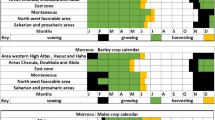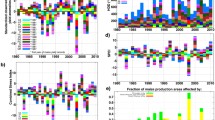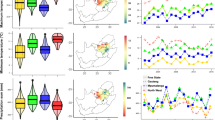Abstract
Southern Africa rainfall station network is suffering from an unfortunate serious decline while climate-related food insecurity is worsening. In the current work, we demonstrate the possibility of exploiting the complementary roles that remote sensing, modeling, and geospatial data analysis can play in forecasting maize yield using data for the growing seasons from 1996/1997 to 2003/2004. Satellite-derived point-specific rainfall estimates were input into a crop water balance model to calculate the Water Requirement Satisfaction Index (WRSI). When these WRSI values were regressed with historical yield data, the results showed that relatively high skill yield forecasts can be made even when the crops are at their early stages of growth and in areas with sparse or without any ground rainfall measurements. Inferences about the yield at national level and small-scale commercial farming sector (SSCF) sector can be made at confidence levels above 99% from the second dekad of February. However, the most unstable models are those for the communal farming sectors whose inferences for yield forecast can only be made above the 95% confidence level from the end of February, after having recovered from a state of complete breakdown two dekads earlier. The large-scale commercial farming (LSCF) sector has generally the weakest fitting, but it is usable from the first dekad of February to the end of the rainy season. Validation of the national yield models using independent data set shows that an early estimation of maize yield is quite feasible by the use of the WRSI.






Similar content being viewed by others
References
AO F (1992) Crop forecasting. technical manual iii for national early warning systems for food security (Zimbabwe). Food and Agriculture Organization, Rome
Ba′ez-Gonza′ lez AD, Jones JGW (1995) Models of sorghum and pearl millet to predict forage dry matter production in semi arid Mexico II. Regression equations. Agric Syst 47:133–145
Domenikiotis C, Spiliotopoulos M, Tsiros E, Dalezios NR (2004) Early cotton yield assessment by the use of NOAA/AVHRR derived Vegetation Condition Index (VCI) in Greece. Int J Remote Sens 14:2807–2819
FAO (1986) Early agrometeorological crop assessment. Food and Agriculture Org., Plant production and protection Paper 73
Hayes MJ, Decker WL (1996) Using NOAA AVHRR data to estimate maize production in the United States corn belt. Int J Remote Sens 17:3189–3200
Herman A, Kumar VB, Arkin PA, Kousky JV (1997) Objectively determined 10-day African rainfall estimates created for famine early warning systems. Int J Remote Sens 18:2147–2159
Nain AS, Dadhwal VK, Singh TP (2002) Real time wheat yields assessment using technology trend and crop simulation model with minimal data set. Curr Sci 82:1255–1258
Nain AS, Dadhwal VK, Singh TP (2004) Use of CERES-Wheat model for wheat yield forecast in central Indo-Gangetic Plains of India. J Agric Sc 142:59–70
Reynolds CA, Yitayew M, Slack DC, Hutchinson CF, Huete A, Petersen MS (2000) Estimating crop yields and production by integrating the FAO Crop specific water balance model with real-time satellite data and ground-based ancillary data. Int J Remote Sens 21:3487–3508
Senay GB, Verdin JP (2003) Characterization of yield reduction in Ethiopia using a GIS-based crop water balance model. Can J Remote Sens 29:687–692
Smith M (1992) Expert consultation on revision of FAO methodologies for crop water requirements. Food and Agriculture Organisation of the United Nations, Rome Italy. FAO Publication 73
Thorne V, Coakeley P, Grimes DIF, Dugdale G (2001) Comparison of TAMSAT and CPC rainfall estimates with raingauges, for southern Africa. Int J Remote Sens 22:1951–1974
Unganai LS, Kogan FN (1998) Drought monitoring and corn yield estimation in southern Africa from AVHRR data. Remote sens Environ 63:219–232
Verdin J, Klaver R (2002) Grid-cell-based crop water accounting for the famine early warning system. Hydrol Process 16:1617–1630
WMO (1992) International meteorological vocabulary. 2nd ed. World Meteorological Organisation (WMO). Geneva. Switzerland. WMO Publication 182
Martin RV, Washington R, Downing TE (2000) Seasonal maize forecasting for South Africa and Zimbabwe derived from an agroclimatological model. J Appl Meteorol 39:1473–1479
Acknowledgments
The Zimbabwe Meteorological Services, the SADC-RRSU, and the Central Statistical Office of Zimbabwe are all thanked for providing data for this work. Bindura University is also thanked for partially financing and providing facilities at the University. Dr L. Unganai and comments from the anonymous reviewers are greatly appreciated as they greatly improved the quality of this paper to the standard acceptable in this prestigious international journal.
Author information
Authors and Affiliations
Corresponding author
Rights and permissions
About this article
Cite this article
Manatsa, D., Nyakudya, I.W., Mukwada, G. et al. Maize yield forecasting for Zimbabwe farming sectors using satellite rainfall estimates. Nat Hazards 59, 447–463 (2011). https://doi.org/10.1007/s11069-011-9765-0
Received:
Accepted:
Published:
Issue Date:
DOI: https://doi.org/10.1007/s11069-011-9765-0




